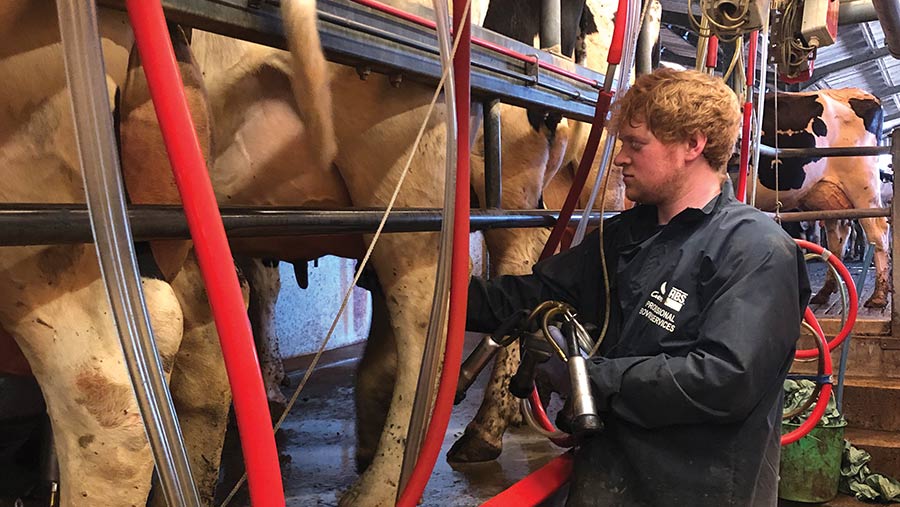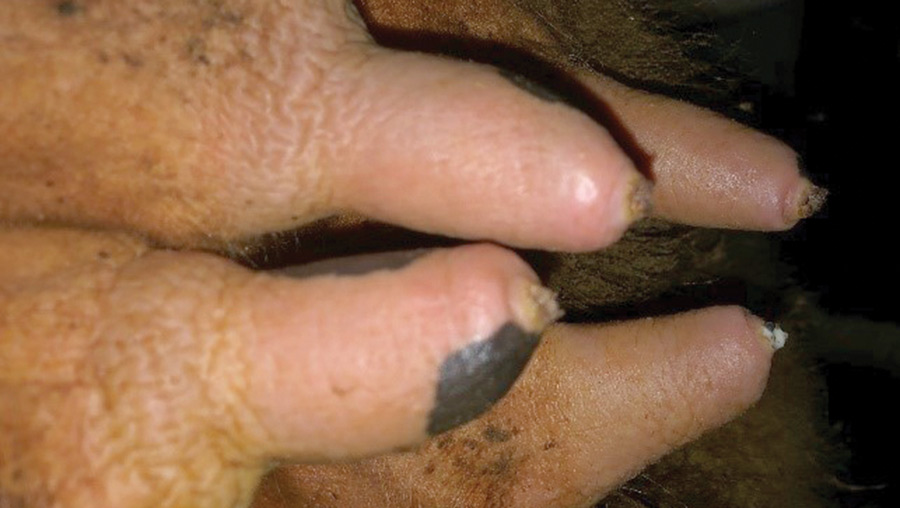How a farmer slashed milking times and improved udder health
 Robert Mayer © Robert Mayer
Robert Mayer © Robert Mayer A Shropshire dairy farmer has cut milking times by two hours a day, improved udder health and reduced antibiotics use by making small tweaks to his parlour settings.
Robert Mayer, who milks 225 cows alongside his father, Bob, at Orslow Manor Farm in Newport, noticed a high proportion of cows were suffering from teat-end damage.
With the herd averaging 35 cases of mastitis per 100 cows annually, to reduce this he enlisted vets who specialise in udder health and milking efficiencies.
Director Tom Greenham of Advance Milking visited the farm in January and carried out a whole-farm assessment.
This involved reviewing health and milking data, observing cow signals and their environment, discussing treatment protocols for mastitis and carrying out a dynamic milking test.
See also: How to make sure your parlour is running properly
Farm facts
- Milks 225 cows
- Supplies milk to the Tesco Sustainable Dairy Group (TSDG)
- Yields 9,250 litres/year at 3.3% protein and 4% butterfat
- Year-round calving
- Housed on sand-bedded cubicles and grazed during the summer
- Farms 227ha on a tenancy
- Milks twice daily through a 24/24 herringbone parlour
Changes to reduce overmilking
A key observation Mr Greenham made was a high prevalence of teat-end hyperkeratosis – rough or damaged teat ends – with 60% of the herd affected compared with a target of less than 15%.
“The milking time machine test highlighted extensive overmilking and excessive vacuum at the teat end as significant causes,” explains Mr Greenham.
Overmilking is a common cause of damaged teat ends, with many automatic cluster removers (ACR) being set at traditional factory settings of 200-250ml/minute.
Therefore, Mr Greenham suggested changing the ACR settings to trigger detachment when milk flow dropped below 600ml/min instead of the original setting of 200ml/min.

Teat-end hyperkeratosis © Tom Greenham
Once this had been successfully implemented, they gradually altered the vacuum by 0.5kpa increments over a number of weeks, to total 1.5kpa. This helped to prevent stressing cows and causing issues with milk letdown.
Hyperkeratosis is semi-permanent, but the condition will improve providing cows are given sufficient dry periods to rest (six weeks).
“Gentler milking settings will prevent new cases of hyperkeratosis developing and allow teat-end health to improve throughout the herd over time,” explains Mr Greenham.
Pre-milking routine
One of the reasons they were able to be so bold with the ACR changes is because the milking protocol at Orslow is exceptionally effective at stimulating milk letdown, says Mr Greenham.
This is important, because cows that are not well stimulated before milking don’t have a clean finish at the end of it, and there is an increased risk of cows not being milked out properly if the ACR settings are adjusted too much.
“[At Orslow] only 3% of milkings showed biphasic milk flow [initial good milk flow, followed by poor flow] compared with a target of less than 15%. This level of performance is almost never seen and is a credit to their thorough pre-milking routine,” he adds.
The routine was adopted four years ago following extensive experimenting by Mr Mayer with different methods.
Two people milk in the 24/24 herringbone parlour. The pre-milking routine involves:
- One person getting the cows into the parlour, while the second milker sprays teats
- Starting from the front and the middle of the parlour, each milker then wipes six cows each. This allows for a 30sec lag time.
- After the sixth cow is wiped, the milker returns to the first to strip each quarter before putting the milking unit on.
Mr Mayer says: “It was the best way I could come up with having slow milkers on at the same time as others while still being heavily parked. I didn’t realise how well it was working.”
Benefits
As well as reducing milk times from 7.5 hours daily to 5.5 hours, yield has also increased from 30.3 litres a cow to 31.3 in the past five months.
The farm employs students from Harper Adams as relief milkers, so the coronavirus pandemic has meant the family, and milker Jarostaw Sadowski, are having to pick up all milking shifts. But the reduction in milking times has helped reduce pressure.
Herd average somatic cell count has also improved from 198,000 cells/ml for July to December 2019 to 111,000 cells/ml from January to May this year.
Furthermore, mastitis incidence has reduced from 35 cases/100 cows to six cases in the past two months.
Antibiotics use at drying-off has already fallen 30% in the past quarter, and Mr Mayer hopes udder health improvements will mean even more cows will be eligible for selective dry cow therapy.
During the initial visit, E coli was identified as the main cause of mastitis, and now only anti-inflammatories are being used to treat cows, which further driving down antibiotics use.
Mr Greenham says: “We know toxic mastitis cases are a tiny proportion of E coli infections, and the vast majority of E coli cases will self-cure. All we need to do is to coax the cow through the initial phase of inflammation. If we can keep cows eating and pain-free, the majority of cases will self-cure.”
